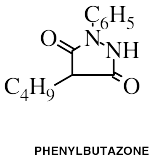

Phenylbutazone
Brand Names: Apo-Phenylbutazone, ApotexPlease read the disclaimer concerning the intent
and limitations of the information provided here.
The information presented in Interactions is for
informational and educational purposes only. It is based on scientific
studies (human, animal, or in vitro), clinical experience, case
reports, and/or traditional usage with sources as cited in each
topic. The results reported may not necessarily occur in all
individuals and different individuals with the same medical conditions
with the same symptoms will often require differing treatments. For
many of the conditions discussed, treatment with conventional medical
therapies, including prescription drugs or over-the-counter
medications, is also available. Consult your physician, an
appropriately trained healthcare practitioner, and/or pharmacist for
any health concern or medical problem before using any herbal products
or nutritional supplements or before making any changes in prescribed
medications and/or before attempting to independently treat a medical
condition using supplements, herbs, remedies, or other forms of
self-care.
![]()
Do not rely solely on the information in this article.
References
Branda RF, Nelson NL. Inhibition of 5-methyltetrahydrofolic acid transport by amphipathic drugs.
Drug Nutr Interact 1981;1(1):45-53.
Abstract: Numerous chemically unrelated drugs after the membrane transport of folate compounds. To investigate drug structure-activity relationships, we measured the effect of amphipathic drugs (that is, compounds with polar-apolar character) on 5-methyltetrahydrofolic acid permeability of human erythrocytes. All drugs tested were inhibitory, but only compounds that exist at least partially in the anionic form were highly active. Ethacrynic acid, sulfinpyrazone, phenylbutazone, sulfasalazine, and furosemide were effective transport inhibitors in micromolar concentrations. In contrast, compounds that are capable of forming cations at physiologic pH, such as chlorpromazine, procaine, tetracaine, and papaverine, were inhibitory only in millimolar concentrations or caused hemolysis before major inhibition was seen. Inhibitory activity correlated with drug dissociation constant (r = 0.87). A double-reciprocal plot analysis of drug effect on 5-methyltetrahydrofolic acid transport showed changes in both Km and Vmax (indicating a mixture of competitive and noncompetitive inhibition) by ethacrynic acid, sulfasalazine, and phlorizin. Inhibitory activity of a series of eight phenoxyacetic derivatives, including ethacrynic acid, correlated highly with measurements of liposolubility (r = 0.87) but only weakly with the Hammet substituent constant (r = 0.56). These results suggest that the effect of amphipathic drugs on 5-methyltetrahydrofolic acid transport is influenced by drug pKa and by the presence of hydrophobic substituents, but is relatively independent of electron-attracting groups.
Hodges R. Drug-nutrient interaction. In: Nutrition in Medical Practice. Philadelphia: W.B. Saunders, 1980:323-331.
Muscat-Baron JM, Freeman DM. Toxic hepatitis following phenylbutazone therapy.
Br J Clin Pract. 1966 Aug;20(8):437-439.